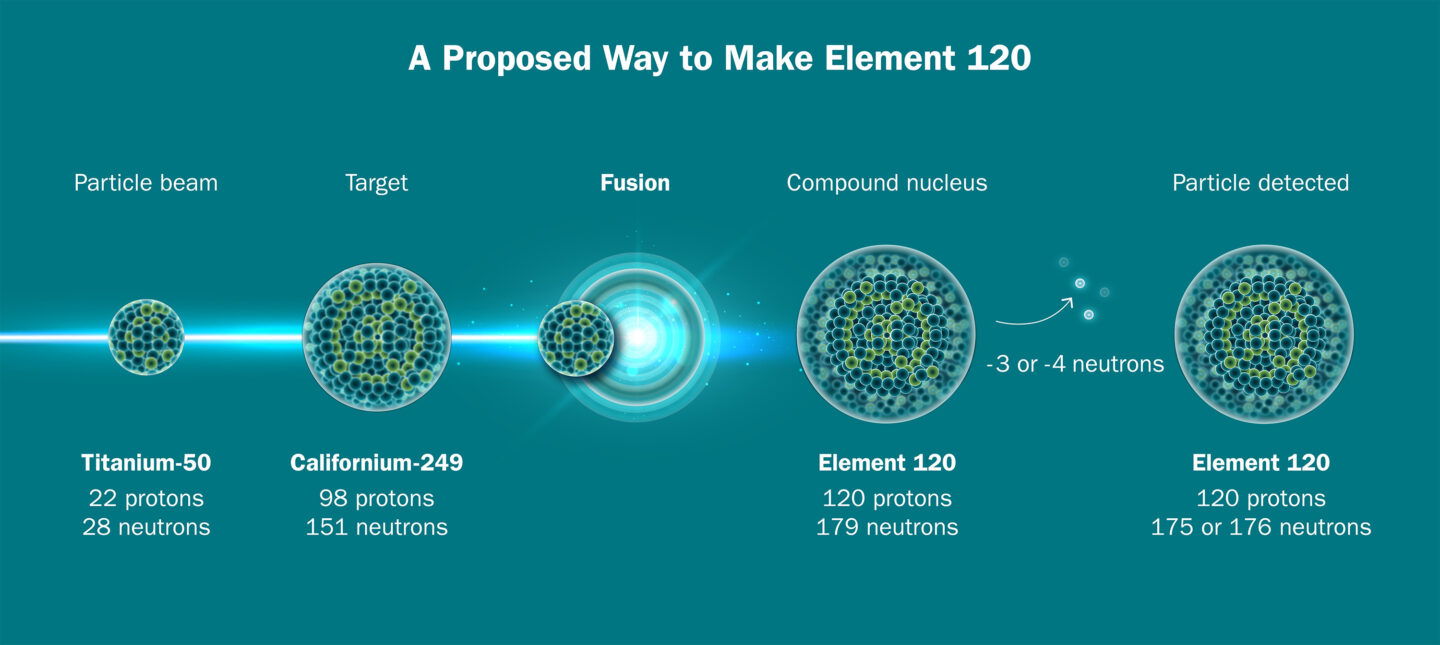In a physics first, scientists at Berkeley Lab have succeeded at creating element 116 using a titanium beam, a development that could set the pace for the creation of heavier elements, including the long-theorized element 120.
The achievement brings scientists closer than ever to creating the heaviest atom ever created by physicists, believed to represent an “island of stability” amid superheavy elements.
With the discovery of 16 of the 118 elements currently known already under its belt, Berkeley Lab’s breakthrough marks a significant step toward bringing such hypothetical elements into existence.
The Hunt for Element 120
Formally known as unbinilium or Ubn, its temporary systematic IUPAC name and symbol, the theorized element 120 (also known by the nickname eka-radium), if officially discovered, would claim its place on the 8th row of the periodic table. For now, the theorized superheavy element is believed to represent an alkaline earth metal or s-block element.
Superheavy elements generally have short lifespans since they have large and very unstable nuclei capable of ripping themselves apart within just seconds of their creation. The instability arises from their size, which results in protons with positive charges within the nuclei repelling each other.


The significance of element 120’s discovery involves its closeness to a theoretical “island of stability” in which superheavy elements are able to overcome these problems of instability and have longer lifespans, thereby allowing scientists a much better opportunity to study them.
Now, an international team of scientists led by the Heavy Element Group at Berkeley Lab says they have made a significant achievement in advance of the creation of element 120: by using a titanium beam, they have successfully created element 116 (livermorium) for the first time.
The announcement, made at the Nuclear Structure 2024 conference and now detailed in a newly submitted study, represents the first success researchers have had in producing element 116 using this method.
“This reaction had never been demonstrated before, and it was essential to prove it was possible before embarking on our attempt to make 120,” says Jacklyn Gates, a nuclear scientist at Berkeley Lab.
Over the course of more than three weeks, the team was successfully able to produce atoms of element 116 on two occasions, with help from the lab’s 88-inch Cyclotron. Significantly, the team’s success using this process means that theoretically, they may also be able to produce element 120, although the process would take far more time. Still, if successful, it would provide physicists an unprecedented view into atomic behavior, insights that could ultimately lead to a deeper understanding of nuclear physics models, as well as the boundaries of atomic nuclei.
Smashing Discoveries
Researchers create superheavy elements by smashing together lighter elements, a process that is far simpler in theory than achieving in real life. For it to be achieved, the process can require as many as trillions of interactions to ensure successful fusion. Further complicating the creation of element 120 is the fact that researchers aren’t able to rely on the commonly utilized calcium-48 beam physicists normally employ in this process, requiring a titanium-50 beam instead.


During their recent research, Berkeley researchers at the 88-Inch Cyclotron first verified that a beam of titanium-50 could be produced at sufficient intensity. Once confirmed, they employed the specialized beam in the otherwise standard process of generating element 116, making it the heaviest element ever produced at Berkeley Lab.
As the titanium ions produced by the beam collide with their target, the Berkeley Gas-filled Separator (BGS) allows the superheavy element 116 to become separated from particle debris. It is thereafter detected by the facility’s Super Heavy RECoil detector (SHREC).
“We’re very confident that we’re seeing element 116 and its daughter particles,” said Jacklyn Gates, a nuclear scientist at Berkeley Lab leading the effort. Successfully employing a titanium beam in the creation of element 116 was significant since calcium-48 is recognized as a “magic” beam, meaning that its unique configuration of protons and neutrons is conducive to its fusion with the target nuclei, which is a crucial aspect of producing superheavy elements.
Jennifer Pore, a scientist in Berkeley Lab’s Heavy Element Group also involved with the achievement, called the team’s success “an important first step” toward eventually bringing element 120 out of the realm of theory and into the lab environment where physicists can study it.
The Edge of Understanding
“When we’re trying to make these incredibly rare elements, we are standing at the absolute edge of human knowledge and understanding, and there is no guarantee that physics will work the way we expect,” Pore said in a statement. “Creating element 116 with titanium validates that this method of production works, and we can now plan our hunt for element 120.”
The team’s ongoing efforts to produce superheavy elements are included in the Nuclear Science Advisory Committee’s 2023 Long-Range Plan for Nuclear Science, although creating a titanium isotope beam of the required strength presents several hurdles. These include the challenge of maintaining a stable output with a new inductive oven, as well as the requirement of being able to manage titanium in conjunction with various gases that it may potentially react with, a factor that may impact overall beam stability.
With the hunt for element 120 effectively underway, the next step will be to craft a special target produced from californium-249, which could equip the research team to begin the experiment by as early as next year, although it will likely require an additional several years simply to produce a few atoms of the fabled element 120.
“We want to figure out the limits of the atom and the periodic table,” Gates said, emphasizing that superheavy elements that are currently recognized are too ephemeral to allow researchers a good opportunity to study them.
“We don’t know what the future holds,” Gates said. “Maybe it’s a better understanding of how the nucleus works, or maybe it’s something more.”
The Berkeley team has submitted a study outlining their groundbreaking new research to the journal Physical Review Letters.
Micah Hanks is the Editor-in-Chief and Co-Founder of The Debrief. He can be reached by email at micah@thedebrief.org. Follow his work at micahhanks.com and on X: @MicahHanks.

